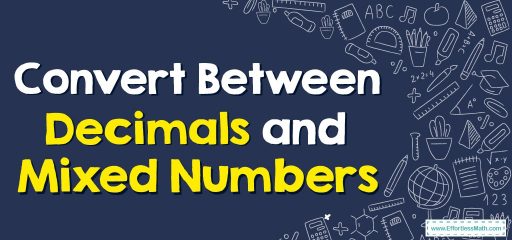Convert Between Decimals and Mixed Numbers

Numbers on the left-hand side of the decimal point show there’s a whole part and several pieces of a whole.
Decimal numbers have two parts that are separated by a decimal point:
Whole part: The numbers on the left-hand side of a decimal point.
Decimal or the fraction part: The numbers on the right-hand side of a decimal point.
To convert a decimal number into a mixed number, the whole number is kept the same and the decimal part is converted.
Convert Between Decimals and Mixed Numbers – Examples 1
Write 3.6 as a mixed fraction.
Solution:
Step 1: Add 1 to the denominator of the decimal number (3.6).
Step 2: Multiply its denominator and the numerator by multiples of 10.
\(3.6=\frac{3.6}{1}=\frac{3.6}{1} \frac{×10}{×10}=\frac{36}{10}\)
Convert Between Decimals and Mixed Numbers – Examples 2
Write \(6 \frac{1}{2}\) as a decimal number.
Solution:
Multiply the numerator and denominator until the denominator becomes a power of 10.
The numbers to the left of the decimal point in the mixed numbers are the integers.
The decimal number to the right of the decimal point in the mixed numbers is the fractional number.
\(6 \frac{1}{2}=6 \frac{1}{2} \frac{×50}{×50}=6 \frac{50}{100}=6.5\)
Related to This Article
More math articles
- A Comprehensive Collection of Free ALEKS Math Practice Tests
- The Ultimate Middle School Math Course (+FREE Worksheets)
- 4th Grade NYSE Math FREE Sample Practice Questions
- The Ultimate 6th Grade TCAP Math Course (+FREE Worksheets)
- Top 10 Free Websites for CHSPE Math Preparation
- What Are the Applications of Inverse Trigonometric Functions?
- How to Solve Radical Equations? (+FREE Worksheet!)
- How to Develop a Love of Math in Your Child!
- 10 Most Common 8th Grade Common Core Math Questions
- 8th Grade PSSA Math Practice Test Questions





































What people say about "Convert Between Decimals and Mixed Numbers - Effortless Math: We Help Students Learn to LOVE Mathematics"?
No one replied yet.